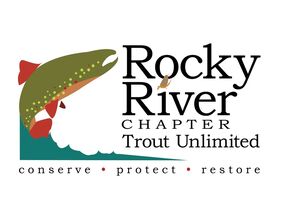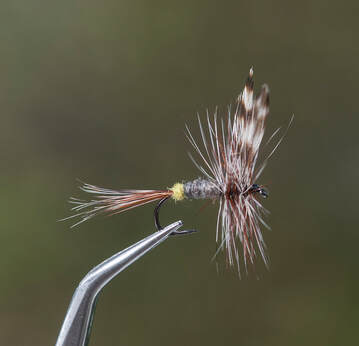Fly of the Month
Some believe that the Female Adams Dry Fly is an independently original Southern Appalachian dry fly pattern. This may or may not be the case for little is known about who originated the addition of the yellow egg sac to the Adams or even other female versions of mayfly fly patterns. The Female Beaverkill Dry Fly is a likely indicator that the egg sac was likely added to the Adams somewhere in the Catskill, long, long ago. Besides being well-known, both the Adams and the Female Adams fly patterns in general have a strong reputation for catching trout everywhere.
Female [Egg Laying] Adams
No doubt there is Female Adams versions of every fly pattern listed above and then some. Imitating the egg laying version of an insect creates a more realistic fly pattern. Trout encounter the egg sac carrying mayflies and may well key on the yellow spot. The yellow is a proven color that attracts an aggressive strike from both wild and hatchery trout. The Female Adams has a hint of yellow with the egg sac tied at the tail using a clump of yellow dubbing or yellow ostrich herl. Does the egg sac attract our southern opportunistic trout or does the yellow color do the trick? A female mayfly with a full egg sac is burdened when first approaching the surface to deposit eggs and is vulnerable. Trout may likewise key on the vulnerability of the insect. Regardless of the reasoning for its success, the female version of a fly pattern is a great addition to the fly box.
The very popular Female Adams was tied and sold by the late Bryson City residence Fred and his wife Allene Hall. This is one of their trademark dry flies that made them fly tying legends here in the south. Fred Hall is credited for originating the Black Adams and the Smokey Mountain Adams. Allene Hall is credited for originating the Female Adams and the Adams Variant. Note that a good number of Southern Appalachian fly patterns use yellow in some manner.
You will often find the Female Adams in fly shops, typically the only commercially available female mayfly fly pattern. You may well find the fly available and sold locally in tackle shops, service stations and general stores throughout the North Carolina mountains where a local tier is making part of his living tying and selling his flies. For example, the Citco along NC 19 in-route to the Nantahala River has a display of locally tied flies that includes (before the sell out each month) the Female Adams tied typically in size 12 and maybe size 14. You will have to tie your own size 16 and size 18.
Female Adams
Fly of the Month 4.18
- Tom Adams, Alen Baker
Some believe that the Female Adams Dry Fly is an independently original Southern Appalachian dry fly pattern. This may or may not be the case for little is known about who originated the addition of the yellow egg sac to the Adams or even other female versions of mayfly fly patterns. The Female Beaverkill Dry Fly is a likely indicator that the egg sac was likely added to the Adams somewhere in the Catskill, long, long ago. Besides being well-known, both the Adams and the Female Adams fly patterns in general have a strong reputation for catching trout everywhere.
Female [Egg Laying] Adams
No doubt there is Female Adams versions of every fly pattern listed above and then some. Imitating the egg laying version of an insect creates a more realistic fly pattern. Trout encounter the egg sac carrying mayflies and may well key on the yellow spot. The yellow is a proven color that attracts an aggressive strike from both wild and hatchery trout. The Female Adams has a hint of yellow with the egg sac tied at the tail using a clump of yellow dubbing or yellow ostrich herl. Does the egg sac attract our southern opportunistic trout or does the yellow color do the trick? A female mayfly with a full egg sac is burdened when first approaching the surface to deposit eggs and is vulnerable. Trout may likewise key on the vulnerability of the insect. Regardless of the reasoning for its success, the female version of a fly pattern is a great addition to the fly box.
The very popular Female Adams was tied and sold by the late Bryson City residence Fred and his wife Allene Hall. This is one of their trademark dry flies that made them fly tying legends here in the south. Fred Hall is credited for originating the Black Adams and the Smokey Mountain Adams. Allene Hall is credited for originating the Female Adams and the Adams Variant. Note that a good number of Southern Appalachian fly patterns use yellow in some manner.
You will often find the Female Adams in fly shops, typically the only commercially available female mayfly fly pattern. You may well find the fly available and sold locally in tackle shops, service stations and general stores throughout the North Carolina mountains where a local tier is making part of his living tying and selling his flies. For example, the Citco along NC 19 in-route to the Nantahala River has a display of locally tied flies that includes (before the sell out each month) the Female Adams tied typically in size 12 and maybe size 14. You will have to tie your own size 16 and size 18.
Female Adams
Fly of the Month 4.18
- Tom Adams, Alen Baker
Female Adams
Hook: Tiemco 100 or equivalent 12,14,16,18
Thread Uni 8/0 or equivalent Tan, Brown or Black
Tail : Mix of rooster in Coachman brown and Grizzly spade hackle Abdomen : Rear tag of yellow dubbing with Adams gray dub up to thorax
Wing: Grizzly hen tips
Directions :
Hook: Tiemco 100 or equivalent 12,14,16,18
Thread Uni 8/0 or equivalent Tan, Brown or Black
Tail : Mix of rooster in Coachman brown and Grizzly spade hackle Abdomen : Rear tag of yellow dubbing with Adams gray dub up to thorax
Wing: Grizzly hen tips
Directions :
- Secure hook in vise after debarbing. Begin thread two eyelengths back from the hook eye advancing to the one third mark. Let the bobbin hang.
- Select two Grizzly hen feathers with tips approximately the same size in width and barb length. Match up the feathers by the tips with the curves facing out and away from each other. Strip the tips of excess barbs leaving the length to tie in at about the same length as the hook shank. Tie in where the bobbin is hanging with the tips facing the hook eye, on top of the hook shank beginning with a soft wrap for position adding two or three tight wraps once the position is okay. Lift the hen tips and build a small thread dam, directly in front of the hen tips making them vertical. Divide the tips with thread and two or three X wraps. Advance the thread to the hook bend and let the bobbin hang.
- Select a Grizzly spade hackle and a Coachman Brown spade hackle of approximately the same length and barb length. Gently stroke the barbs at a right angle to the stem. This will cause the barbs to stand out a right angle to the stem, aiding in aligning the tips. Holding the barb tips tightly and pulling firmly away from the stem will keep the tips of the barbs even.
- Tie in the mix of hackle on top of the hook shank with the length of the tail about the same as the hook shank. The first wraps of the tail should be closer to the head than the bend and the first wrap should be firm with touching wraps to the hook bend and almost no pressure at the hook bend. Too much pressure at the hook bend with cause the tailing to stand up or flair. Let the bobbin hang.
- Begin dubbing with tight, small noodles of yellow dry fly dub to form a very small "egg sac". Let the bobbin hang.
- Select a small portion of superfine or dry fly dubbing in Adams gray forming a tight noodle of dubbing. Do not try to have the full abdomen in the first noodle. It is easier to add dubbing and too much will make the abdomen have a bulky profile. Mayflies have very thin abdomen. The dub should stop at the two thirds mark. Let the bobbin hang.
- Select two rooster hackles, one grizzly and one coachman brown. Match the hackles to about one and one half the hook gape. Strip about 1/4 inch of the barbs from the hackles. Match up the curve and tips of the hackles and tie in with the natural curve away from the eye. Tie in with a soft wrap immediately behind the wings and a soft wrap in front adding two or three firm wraps to bind in the hackles with the last wrap behind the wing and trapping the hackle at the end of the dubbing. There should be a small portion of stem without barbs still exposed. This will allow the first wrap to be free of barbs and avoid any bunching. Advance the thread to the front of the wings and let the bobbin hang. Begin wrapping the brown hackle, making three or so turns behind the wing and two in front of the wing. When wrapping, leave a very slight space between the wraps to allow for the next wrap of grizzly. Bind in the brown in front of the wing leaving room for a head as well as the grizzly. Trim waste stem and let the bobbin hang. Wrap the grizzly in turns going between the brown hackle with three or so turns behind the eye and two or so in front. Tie off. Trim the waste.
- Form a small thread head and make a three or four turn whip finish and cut the thread.

